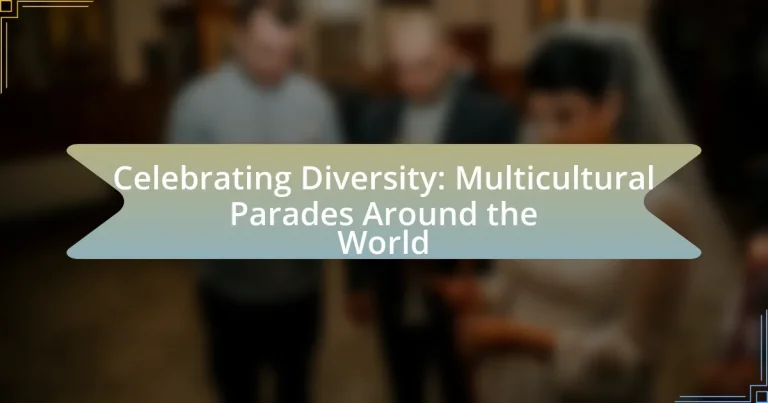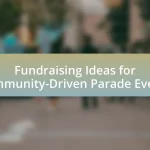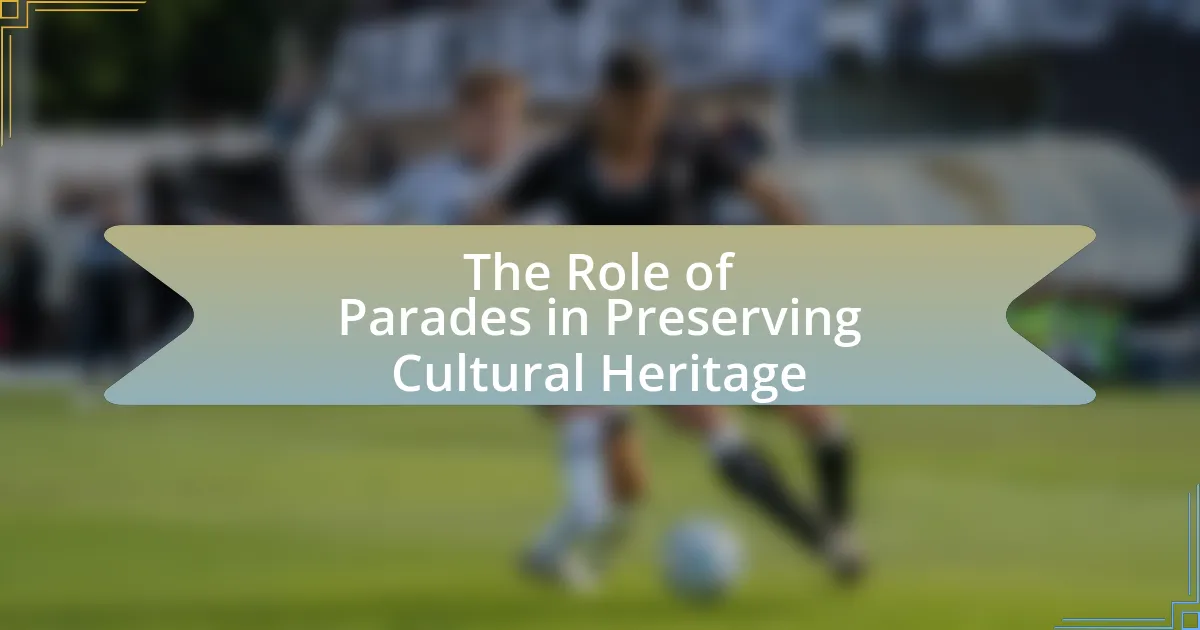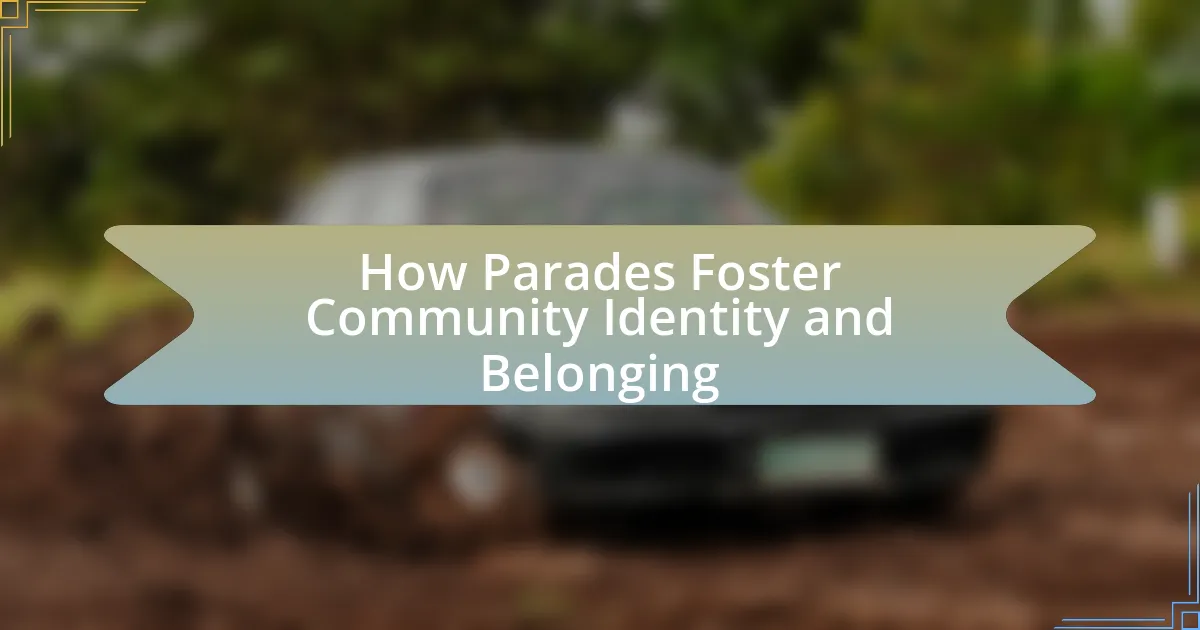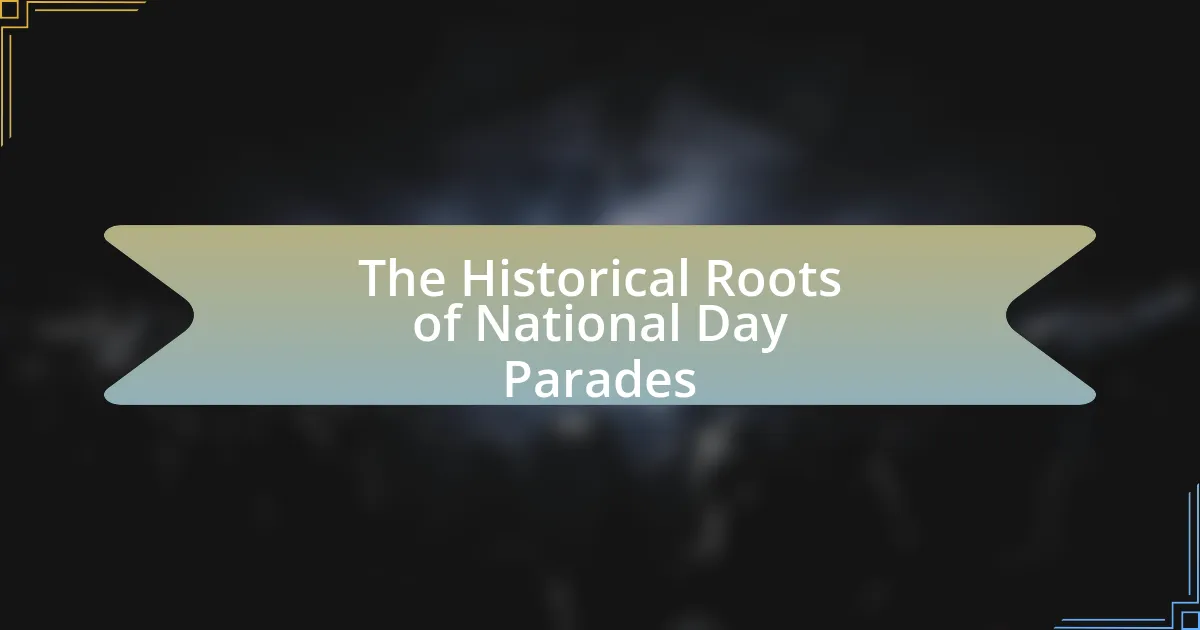Multicultural parades are public celebrations that highlight the cultural diversity of communities through music, dance, costumes, and traditional practices. These events foster unity and inclusion by showcasing the unique heritages of various ethnic groups, as seen in notable parades like the New York City West Indian Day Parade and London’s Notting Hill Carnival. The article explores the significance of these parades in promoting cultural awareness, social cohesion, and community engagement, while also addressing challenges such as logistical coordination and cultural representation. Additionally, it discusses the role of local businesses, volunteers, and organizations in the success of these events, as well as common misconceptions that can affect public perception and participation.
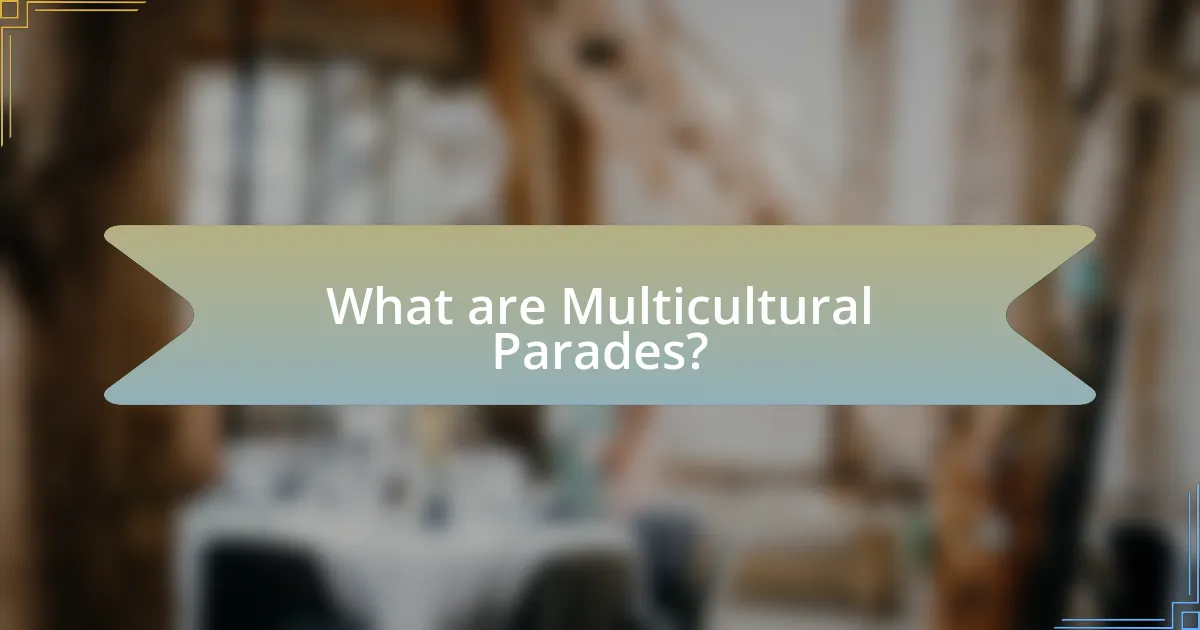
What are Multicultural Parades?
Multicultural parades are public celebrations that showcase the cultural diversity of a community through music, dance, costumes, and traditional practices. These events often feature participants from various ethnic backgrounds, highlighting their unique heritages and fostering a sense of unity and inclusion. For instance, the New York City West Indian Day Parade celebrates Caribbean culture and attracts over a million attendees each year, demonstrating the significance of multicultural parades in promoting cultural awareness and appreciation.
How do multicultural parades celebrate diversity?
Multicultural parades celebrate diversity by showcasing the cultural heritage, traditions, and artistic expressions of various ethnic groups. These events feature vibrant displays of music, dance, costumes, and food that represent the unique identities of participating communities. For instance, the annual Notting Hill Carnival in London highlights Caribbean culture through colorful costumes and calypso music, attracting over a million attendees and fostering cross-cultural understanding. Such parades not only promote inclusivity but also encourage dialogue among different cultural groups, reinforcing the value of diversity in society.
What cultural elements are typically showcased in these parades?
Cultural elements typically showcased in multicultural parades include traditional costumes, music, dance, and culinary displays. Traditional costumes reflect the heritage and identity of various cultures, often featuring vibrant colors and intricate designs that represent specific regions or communities. Music played during these parades often includes folk songs and contemporary pieces that resonate with the cultural background being represented, enhancing the festive atmosphere. Dance performances, ranging from traditional folk dances to modern interpretations, serve as a dynamic expression of cultural storytelling and community pride. Additionally, culinary displays featuring traditional foods allow participants and spectators to experience the flavors of different cultures, further enriching the celebration of diversity. These elements collectively highlight the unique characteristics of each culture, fostering appreciation and understanding among diverse audiences.
How do participants express their cultural identities during these events?
Participants express their cultural identities during multicultural parades through traditional attire, music, dance, and food. For instance, wearing specific costumes that reflect cultural heritage allows individuals to visually represent their backgrounds, while traditional music and dance performances showcase cultural practices and storytelling. Additionally, food stalls featuring traditional dishes provide a sensory experience that connects participants to their cultural roots. These expressions are vital for fostering community pride and promoting cultural awareness among diverse audiences.
Why are multicultural parades important for communities?
Multicultural parades are important for communities because they promote cultural awareness and foster social cohesion. These events allow diverse groups to showcase their traditions, languages, and customs, which enhances mutual respect and understanding among community members. For instance, studies have shown that participation in multicultural events can reduce prejudice and increase community engagement, as seen in cities like New York and Los Angeles, where such parades attract thousands and encourage interaction among different cultural groups.
What role do these parades play in promoting social cohesion?
Multicultural parades play a significant role in promoting social cohesion by fostering a sense of community and shared identity among diverse groups. These events bring together individuals from various cultural backgrounds, encouraging interaction and mutual understanding. For instance, studies have shown that participation in community events like parades can enhance social networks and reduce feelings of isolation, which are crucial for building cohesive societies. Additionally, parades often celebrate cultural heritage, allowing participants to express their identities while also inviting others to appreciate and learn about different traditions, thus reinforcing social bonds and inclusivity.
How do they contribute to cultural awareness and education?
Multicultural parades contribute to cultural awareness and education by showcasing diverse traditions, customs, and histories from various communities. These events provide a platform for participants to share their cultural heritage through performances, costumes, and food, fostering understanding and appreciation among attendees. For instance, the annual Notting Hill Carnival in London celebrates Caribbean culture, attracting over a million visitors and educating them about its music, dance, and culinary traditions. Such parades not only promote inclusivity but also serve as educational experiences, allowing individuals to learn about and engage with cultures different from their own.

Where are some of the most famous multicultural parades held?
Some of the most famous multicultural parades are held in cities like Rio de Janeiro, Brazil; New York City, USA; and London, UK. The Rio Carnival is renowned for its vibrant samba parades, attracting millions of participants and spectators each year. New York City’s West Indian Day Parade celebrates Caribbean culture and heritage, featuring colorful costumes and lively music. London’s Notting Hill Carnival is one of the largest street festivals in Europe, showcasing Caribbean culture with a rich display of music, dance, and food. These events exemplify the celebration of diversity through cultural expression and community participation.
What are notable examples of multicultural parades around the world?
Notable examples of multicultural parades around the world include the Notting Hill Carnival in London, the Mardi Gras in Sydney, and the Chinese New Year Parade in San Francisco. The Notting Hill Carnival, held annually since 1966, celebrates Caribbean culture and attracts over a million attendees. Mardi Gras, celebrated since 1978, showcases LGBTQ+ pride and cultural diversity, drawing around 1.5 million participants. The Chinese New Year Parade, one of the largest outside Asia, features traditional performances and attracts over 1 million spectators, highlighting the rich heritage of the Chinese community in the United States.
How do the themes of these parades differ by location?
The themes of multicultural parades differ significantly by location, reflecting the unique cultural, historical, and social contexts of each area. For instance, the Rio Carnival in Brazil emphasizes vibrant music and dance, showcasing Afro-Brazilian heritage, while the Chinese New Year parades in cities like San Francisco focus on traditional customs, dragon dances, and family reunions, highlighting Chinese cultural values. Additionally, the Mardi Gras celebration in New Orleans incorporates elements of French, Spanish, and African American traditions, emphasizing community and revelry. These variations illustrate how local histories and demographics shape the themes and expressions of parades, making each event a distinct representation of cultural identity.
What unique traditions are associated with specific parades?
Unique traditions associated with specific parades include the vibrant costumes and elaborate floats of the Rio Carnival in Brazil, which celebrate Afro-Brazilian culture and samba music. In New Orleans, the Mardi Gras parade features masked balls and the throwing of beads, rooted in French Catholic traditions. The Diwali Festival in India showcases colorful rangoli designs and fireworks during its parades, symbolizing the victory of light over darkness. Each of these parades reflects the cultural heritage and community values of their respective regions, reinforcing the significance of diversity in global celebrations.
How do local communities participate in these parades?
Local communities participate in multicultural parades by organizing events, showcasing cultural performances, and engaging in volunteer activities. These parades often feature local groups that prepare floats, costumes, and traditional music, reflecting their unique cultural heritage. For instance, in cities like New York and Los Angeles, community organizations collaborate to represent various ethnic backgrounds, contributing to the vibrant atmosphere of the parades. This active involvement not only fosters a sense of pride among participants but also promotes cultural awareness and appreciation among attendees.
What roles do volunteers and organizations play in the success of these events?
Volunteers and organizations are crucial for the success of multicultural parades as they provide essential manpower, resources, and logistical support. Volunteers often assist in planning, coordinating activities, and managing crowds, which ensures smooth operations during the event. Organizations contribute by securing permits, funding, and sponsorships, which are vital for the financial viability of these parades. For instance, the New York City Pride Parade relies heavily on both volunteers and organizations like the NYC Pride organization to facilitate its large-scale operations, demonstrating that effective collaboration between volunteers and organizations directly impacts the event’s success.
How do local businesses benefit from multicultural parades?
Local businesses benefit from multicultural parades primarily through increased foot traffic and sales opportunities. During these events, large crowds gather, creating a surge in potential customers for nearby shops and restaurants. For instance, a study by the National Endowment for the Arts found that cultural events can boost local economies by up to 20%, as businesses capitalize on the influx of attendees seeking food, merchandise, and services. Additionally, multicultural parades often promote community engagement, leading to enhanced brand visibility and customer loyalty for local enterprises.
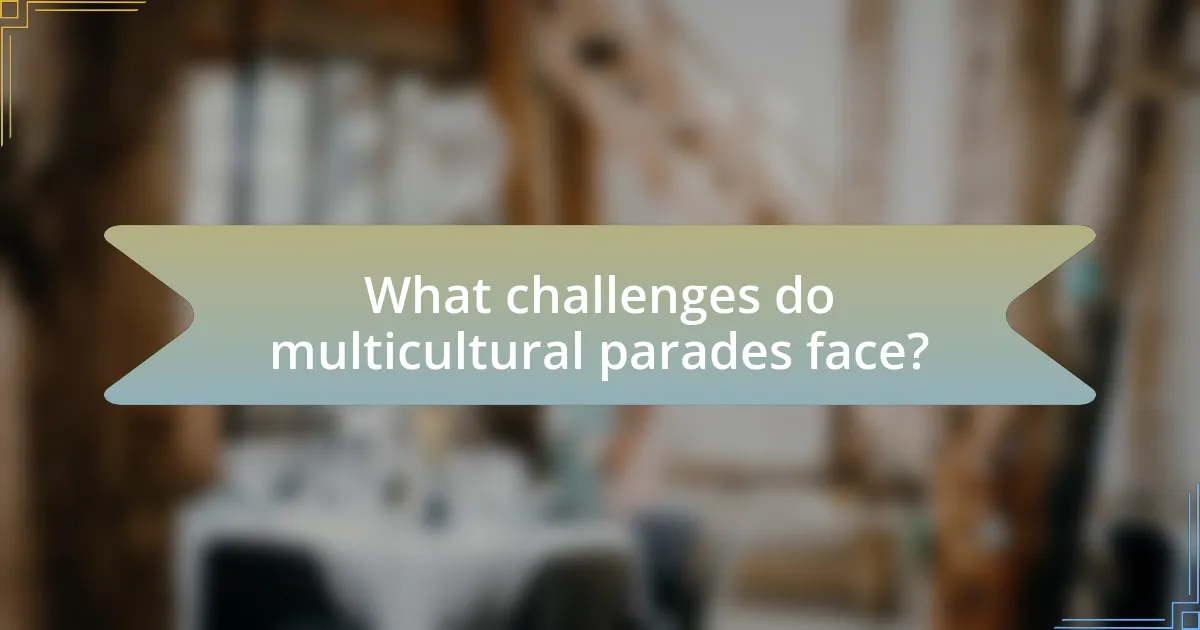
What challenges do multicultural parades face?
Multicultural parades face challenges such as logistical coordination, cultural representation, and community engagement. Logistical coordination involves managing permits, security, and crowd control, which can be complex due to the diverse nature of participants and audiences. Cultural representation challenges arise when ensuring that all cultures are accurately and respectfully portrayed, preventing stereotypes and misrepresentation. Community engagement is crucial, as parades must foster participation from various cultural groups while also appealing to a broader audience, which can be difficult to achieve. These challenges can impact the overall success and inclusivity of the event.
How do organizers address logistical issues during these events?
Organizers address logistical issues during multicultural parades by implementing detailed planning and coordination strategies. They typically create comprehensive event timelines, allocate resources effectively, and establish clear communication channels among all stakeholders, including vendors, volunteers, and local authorities. For instance, successful parades often utilize technology for real-time updates and crowd management, ensuring safety and efficiency. Additionally, organizers conduct thorough risk assessments and develop contingency plans to address potential challenges, such as inclement weather or crowd control, which are critical for maintaining the event’s flow and safety.
What safety concerns are associated with large public gatherings?
Large public gatherings pose several safety concerns, including crowd control issues, potential for violence, and health risks. Crowd control challenges can lead to stampedes or crushes, as seen in incidents like the 2015 Hajj stampede in Mecca, which resulted in over 2,400 fatalities. The potential for violence, including terrorism or civil unrest, is heightened in large crowds, evidenced by attacks such as the 2017 Manchester Arena bombing, which killed 22 people. Additionally, health risks, particularly during pandemics, can arise from close contact among attendees, as demonstrated during the COVID-19 outbreak, where large gatherings contributed to virus transmission.
How do weather conditions impact the planning of multicultural parades?
Weather conditions significantly impact the planning of multicultural parades by influencing scheduling, logistics, and participant safety. For instance, adverse weather such as rain or extreme heat can lead organizers to reschedule events to ensure comfort and safety for attendees and participants. Historical data shows that parades held in inclement weather often see reduced attendance; for example, the 2019 New York City Pride Parade experienced a drop in participants due to heavy rain, highlighting the importance of weather considerations in planning. Additionally, weather forecasts are crucial for logistical arrangements, including float construction and sound equipment protection, ensuring that all elements function optimally during the event.
What are common misconceptions about multicultural parades?
Common misconceptions about multicultural parades include the belief that they solely focus on entertainment rather than cultural education. In reality, these parades aim to promote understanding and appreciation of diverse cultures through educational displays, performances, and community engagement. Another misconception is that they represent only a single culture or ethnicity; however, multicultural parades typically showcase a variety of cultural groups, highlighting the richness of diversity within a community. Additionally, some people think that these events are only for participants from specific cultural backgrounds, but they are designed to be inclusive, inviting everyone to celebrate and learn about different traditions.
How can these misconceptions affect public perception and participation?
Misconceptions about multicultural parades can significantly skew public perception and reduce participation. When individuals believe that these events are merely celebrations of cultural stereotypes or that they promote division rather than unity, they may disengage from participating or supporting such initiatives. Research indicates that negative stereotypes can lead to social exclusion, as seen in studies by the Pew Research Center, which found that misinterpretations of cultural events often result in lower community involvement and increased polarization. Consequently, these misconceptions not only diminish the perceived value of multicultural parades but also hinder the potential for fostering inclusivity and understanding among diverse groups.
What steps can be taken to educate the public about the true nature of these events?
To educate the public about the true nature of multicultural parades, organizations can implement community workshops that focus on the historical and cultural significance of these events. These workshops can provide factual information about the origins of various parades, such as the Carnival in Rio de Janeiro, which celebrates Afro-Brazilian culture and has roots in both African and Portuguese traditions. Additionally, educational campaigns utilizing social media platforms can disseminate engaging content, including videos and infographics, that highlight the diverse cultural expressions represented in these parades. Research shows that community engagement and interactive learning significantly enhance understanding and appreciation of cultural diversity, as evidenced by studies conducted by the National Endowment for the Arts, which found that participation in cultural events fosters greater social cohesion and awareness.
What are some best practices for organizing a successful multicultural parade?
To organize a successful multicultural parade, it is essential to ensure inclusive representation of diverse cultures. This involves engaging community leaders and cultural organizations to participate and showcase their traditions, which fosters a sense of belonging and respect among participants. Additionally, effective communication and marketing strategies should be employed to promote the event widely, ensuring that the parade reaches a broad audience and encourages community involvement.
Logistical planning is also critical; this includes securing permits, arranging for safety measures, and coordinating transportation and accessibility options for all attendees. Furthermore, incorporating educational elements, such as workshops or informational booths, can enhance the experience by providing context about the cultures represented.
Research indicates that successful multicultural events often lead to increased community cohesion and understanding, as seen in studies conducted by the National Endowment for the Arts, which highlight the positive impact of cultural celebrations on social integration.
